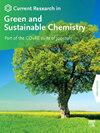Biochar derived from citronella and oregano waste residues for removal of organic dyes and soil amendment
Q2 Materials Science
Current Research in Green and Sustainable Chemistry
Pub Date : 2024-01-01
DOI:10.1016/j.crgsc.2024.100433
引用次数: 0
Abstract
The exponential growth and prominence of the essential oil industry was associated with the generation of large amounts of plant residues which, if not managed properly, present an environmental threat due to their ability to contaminate soil and water systems. This study focuses on the valorization of residues generated from oregano and citronella plants following essential oil extraction. To tackle this challenge, we investigated the potential of biochar of oregano and citronella residues for removing methyl orange dye, a common environmental pollutant, and assessed their phytotoxicity for potential applications as soil amendment. The biochar was produced at different pyrolysis temperatures (300 °C and 400 °C) to study the effect of temperature on the various physicochemical properties of the biochar. Several analytical techniques were used to characterize the generated biochar including Fourier Transform infrared (FTIR) spectroscopy, Scanning Electron Microscopy (SEM), X-ray energy dispersive (EDX) spectroscopy, and X-ray diffraction (XRD) spectroscopy. The efficiency of oregano and citronella biochars produced at different temperatures as soil amendment was evaluated by examining the germination and root development of Lepidium sativum seeds commonly known as garden cress. The control group displayed strong performance with 90–100 % germination and 3.54 cm root length. Oregano biochar obtained by pyrolysis at 300 °C (BOR-300) was toxic to seed growth, while the biochar fabricated at 400 °C (BOR-400) improved germination but fell short of the control. On the other hand, citronella biochar generated at 300 °C (BCR-300) and 400 °C (BCR-400) resulted in better germination compared to BOR, but still lagged behind the control group. Furthermore, our results demonstrated that citronella biochar (BCR) at 400 °C effectively removed 88.8 % of the methyl orange dye. Conversely, the combination of oregano biochar (BOR) and citronella biochar (BCR) at 300 °C did not substantially affect the dye removal efficiency. In summary, applying BOR and BCR produced at 400 °C to soil appears environmentally safe but does not significantly enhance plant growth. These results highlight the critical roles played by biochar type and pyrolysis temperature in shaping the application process.
从香茅和牛至废渣中提取生物炭,用于去除有机染料和改良土壤
精油产业的迅猛发展和显著地位与大量植物残留物的产生有关,如果管理不当,这些残留物会污染土壤和水系统,对环境造成威胁。本研究的重点是牛至和香茅植物提取精油后产生的残留物的价值化。为了应对这一挑战,我们研究了牛至和香茅残留物的生物炭去除常见环境污染物甲基橙染料的潜力,并评估了它们作为土壤改良剂的潜在应用的植物毒性。生物炭在不同的热解温度(300 ℃ 和 400 ℃)下生产,以研究温度对生物炭各种理化性质的影响。对生成的生物炭采用了多种分析技术,包括傅立叶变换红外(FTIR)光谱、扫描电子显微镜(SEM)、X 射线能量色散(EDX)光谱和 X 射线衍射(XRD)光谱。通过检测鳞茎芹种子的发芽和根系发育情况,评估了在不同温度下生产的牛至和香茅生物皂作为土壤改良剂的效率。对照组表现优异,发芽率为 90-100 %,根长为 3.54 厘米。通过 300 °C 高温分解获得的牛至生物炭(BOR-300)对种子生长有毒害作用,而在 400 °C 高温下制造的生物炭(BOR-400)则提高了发芽率,但低于对照组。另一方面,与 BOR 相比,在 300 °C(BCR-300)和 400 °C(BCR-400)下生成的香茅生物炭的发芽率更高,但仍落后于对照组。此外,我们的结果表明,400 °C的香茅生物炭(BCR)能有效去除88.8%的甲基橙染料。相反,牛至生物炭(BOR)和香茅生物炭(BCR)在 300 °C 下的组合并没有对染料去除效率产生重大影响。总之,在土壤中施用在 400 °C 下生产的牛至生物炭和香茅生物炭似乎对环境安全,但并不能显著促进植物生长。这些结果凸显了生物炭类型和热解温度在应用过程中的关键作用。
本文章由计算机程序翻译,如有差异,请以英文原文为准。
求助全文
约1分钟内获得全文
求助全文
来源期刊

Current Research in Green and Sustainable Chemistry
Materials Science-Materials Chemistry
CiteScore
11.20
自引率
0.00%
发文量
116
审稿时长
78 days
 求助内容:
求助内容: 应助结果提醒方式:
应助结果提醒方式:


